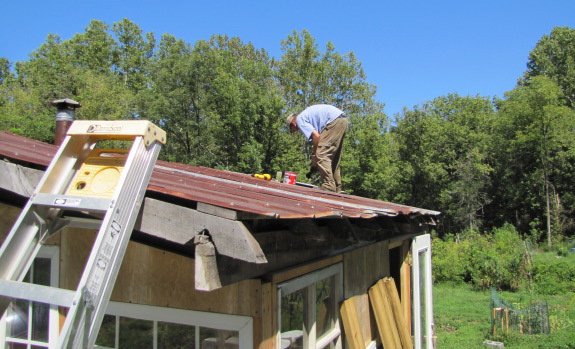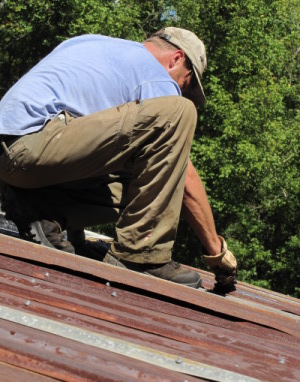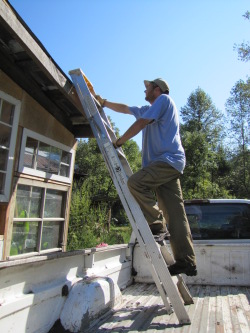
Canon Power Shot roof images


Putting the final piece of tin on the roof sort of feels like the last
piece of a marathon jig saw puzzle.

We recently upgraded the
WaldenEffect blog camera from the Fuji
Finepix S1000fd to a
beefier Canon Power
Shot SX20. I can already
tell a difference, but will wait for more experimentation before I give
a full report on how awesome it is.
Want more in-depth information? Browse through our books.
Or explore more posts by date or by subject.
About us: Anna Hess and Mark Hamilton spent over a decade living self-sufficiently in the mountains of Virginia before moving north to start over from scratch in the foothills of Ohio. They've experimented with permaculture, no-till gardening, trailersteading, home-based microbusinesses and much more, writing about their adventures in both blogs and books.
Want to be notified when new comments are posted on this page? Click on the RSS button after you add a comment to subscribe to the comment feed, or simply check the box beside "email replies to me" while writing your comment.

Thank you! We really love taking pictures, and I'm always glad to see that someone enjoys them.
Even though I'm usually an advocate of book-learning, I'm not when it comes to taking good photos. Instead, I think you should get a digital camera, then start taking lots of pictures and putting them on your computer to look at immediately. The great thing about a digital camera is that taking a hundred pictures costs nothing --- if you don't like them, just delete them. You'll teach yourself how to take good shots as long as you're willing to take a bunch of them.
I think that it's important to get a good camera, but I don't think you need to spend too much on it either. The newest edition of the Fuji would be a very good choice for a moderately priced (less than $200) camera that takes awesome pictures.
Clearly I have more tips than I thought I did.
At least at first, you should probably stick to taking photos outside in natural light. It's amazing what a difference bright light makes in photography.
Probably the most common thing I see that changes a brilliant photo into a mediocre photo is not getting in close enough to the subject. Try to fill the entire photo with whatever you're taking a picture of, and even chop off a bit of the edges. Notice how the big picture at the top of this post just doesn't grab you as much as the two lower pictures. By lopping off part of Mark's butt and part of the truck, I suck you into the image.
And I'm going to stop now because I'm about to give a lecture on composition --- diagonals, negative space, etc. That might be worth reading up on if you've never taken an art class. In fact, if I was going to recommend a book for you, I'd recommend a beginning art book to train your eye on composition, not one about photography.
Anna- my previous camera was one of the little Cannon's and it was pretty good. The newer versions of the power shot are even better. Now I've got Sony's version because that's what was available when my Cannon died while on a trip. New Rule: Do not drop your digital camera all the time!
Mizztanya-- everything Anna said is great advice, especially the part about studying composition instead of "Photography." Look at all kinds of art and notice where the subjects are placed in the frame, what you notice, etc. concentrate on looking at pre WWI works if you can. The modern lack of compositional control can be really confusing.
Another couple of things that helped me a lot were to 1: convert (at least temporarily) all my images to black & white. That will help you see the composition better. Then return them to color and see if there is anything that distracts from the subject. (Looking at what's around "the picture" is a hugely important skill.)
2: Once you feel comfortable with your camera set yourself a limit of, say, 36 pictures and spend a day photographing like mad.... but you can only have that many pictures on your camera at one time... so it eventually becomes a one in / one out proposition which will help you make better pictures because all that deleting sucks. When you find something that just HAS to be shot you then need to delete the worst of what you already have. I did that on an 8 day hike ten years ago (when each memory card held THAT "massive" storage ability) and although I don't have pictures of everything I saw I have a few really fantastic pictures that remind me of the trip and my accomplishment.
Anna- my previous camera was one of the little Cannons and it was pretty good. The newer versions of the power shot are even better. Now I've got Sony's version because that's what was available when my Cannon died while on a trip. New Rule: Do not drop your digital camera all the time!
Mizztanya-- everything Anna said is great advice, especially the part about studying composition instead of "Photography." Look at all kinds of art and notice where the subjects are placed in the frame, what you notice, etc. concentrate on looking at pre WWI works if you can. The modern lack of compositional control can be really confusing.
Another couple of things that helped me a lot were to 1: convert (at least temporarily) all my images to black & white. That will help you see the composition better. Then return them to color and see if there is anything that distracts from the subject. (Looking at what's around "the picture" is a hugely important skill.)
2: Once you feel comfortable with your camera set yourself a limit of, say, 36 pictures and spend a day photographing like mad.... but you can only have that many pictures on your camera at one time... so it eventually becomes a one in / one out proposition which will help you make better pictures because all that deleting sucks. When you find something that just HAS to be shot you then need to delete the worst of what you already have. I did that on an 8 day hike ten years ago (when each memory card held THAT "massive" storage ability) and although I don't have pictures of everything I saw I have a few really fantastic pictures that remind me of the trip and my accomplishment.